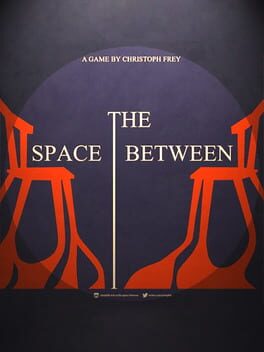So there's this thing I sometimes feel when going into modern art museums, in which I feel like the intended meaning behind a piece of art is nigh incomprehensible to anyone who doesn't have not just an art history degree, but is an artist themselves. It's this sense that people are talking in a coded language specifically as a challenge to the viewer, to see if it is possible for the viewer, through training and access to this language, understand the meaning of the piece of art before them.
And since the majority of people do not have art history degrees, they inevitably fail. I usually really enjoy modern art exhibits, but I think a lot of this enjoyment has to do with the fact that I usually get an audioguide to go along with me, helping me contextualize the pieces in front of me. And sometimes, I think to myself, "why was this context not a part of the work itself?"
Playing The Space Between was like that.
The game itself is an extended meditation on the nature of separation, on who we are and the barriers we place between us and others, and whether true intimacy is actually possible. It decides to represent this by an extended analogy of reaching and touching someone from behind a sheet and wondering whether it is them or the sheet that you feel. Dialogue is painfully slow, although obviously deliberately so, and blends together as you, an architect named Martin Melanson, meet a woman named Clara, and proceed to show her the theatre you're building, specifically the "hell" that you've created for yourself underneath the stage as a personal room.
In about an hour, this game manages to fit in childhood trauma, a strange murder intrigue, meditations about whether actors or audience are really the ones able to see each other, and more, and it all simultaneously feels like it is drowning for lack of space and sparse beyond belief.
This is a game where interactivity adds very little, beyond to blur the fourth wall of who your character actually is. Dialogue's insistence on not delineating who is talking, you or Clara, increases this confusion, and that confusion becomes almost the entire point of the game. And it's just... Allergic to telling you what it wants to say.
The whole experience is one of feeling like the author has deliberately put up barriers to comprehending the game, which is obviously part of the theme considering how much of the rest of the game is deliberately blurry, from the text to the VCR aesthetic the game goes for. But like some of those modern art pieces, I ended up wondering why this context was placed outside of the game, why the confusion was something worth creating.
It is elitism to the highest degree, which is ironic considering the game looks deliberately like it had a 2000 polygon limit. Maybe I'm just too smooth brained for it, and I absolutely hate that this is my core criticism, but when the game is deliberately trying to opaque, I don't feel bad about criticizing it for its opacity.
Catherine Brinegar has a decent 3 part analysis here: https://www.rebind.io/tearing-down-the-house-an-exploration-of-the-space-between-part-1-1467/
https://www.rebind.io/burning-down-the-house-delving-deeper-into-the-space-between-part-2-1480/
https://www.rebind.io/cleaning-up-the-house-deconstructing-the-space-between-part-3-1495/
And since the majority of people do not have art history degrees, they inevitably fail. I usually really enjoy modern art exhibits, but I think a lot of this enjoyment has to do with the fact that I usually get an audioguide to go along with me, helping me contextualize the pieces in front of me. And sometimes, I think to myself, "why was this context not a part of the work itself?"
Playing The Space Between was like that.
The game itself is an extended meditation on the nature of separation, on who we are and the barriers we place between us and others, and whether true intimacy is actually possible. It decides to represent this by an extended analogy of reaching and touching someone from behind a sheet and wondering whether it is them or the sheet that you feel. Dialogue is painfully slow, although obviously deliberately so, and blends together as you, an architect named Martin Melanson, meet a woman named Clara, and proceed to show her the theatre you're building, specifically the "hell" that you've created for yourself underneath the stage as a personal room.
In about an hour, this game manages to fit in childhood trauma, a strange murder intrigue, meditations about whether actors or audience are really the ones able to see each other, and more, and it all simultaneously feels like it is drowning for lack of space and sparse beyond belief.
This is a game where interactivity adds very little, beyond to blur the fourth wall of who your character actually is. Dialogue's insistence on not delineating who is talking, you or Clara, increases this confusion, and that confusion becomes almost the entire point of the game. And it's just... Allergic to telling you what it wants to say.
The whole experience is one of feeling like the author has deliberately put up barriers to comprehending the game, which is obviously part of the theme considering how much of the rest of the game is deliberately blurry, from the text to the VCR aesthetic the game goes for. But like some of those modern art pieces, I ended up wondering why this context was placed outside of the game, why the confusion was something worth creating.
It is elitism to the highest degree, which is ironic considering the game looks deliberately like it had a 2000 polygon limit. Maybe I'm just too smooth brained for it, and I absolutely hate that this is my core criticism, but when the game is deliberately trying to opaque, I don't feel bad about criticizing it for its opacity.
Catherine Brinegar has a decent 3 part analysis here: https://www.rebind.io/tearing-down-the-house-an-exploration-of-the-space-between-part-1-1467/
https://www.rebind.io/burning-down-the-house-delving-deeper-into-the-space-between-part-2-1480/
https://www.rebind.io/cleaning-up-the-house-deconstructing-the-space-between-part-3-1495/

Yultimona
1 year ago